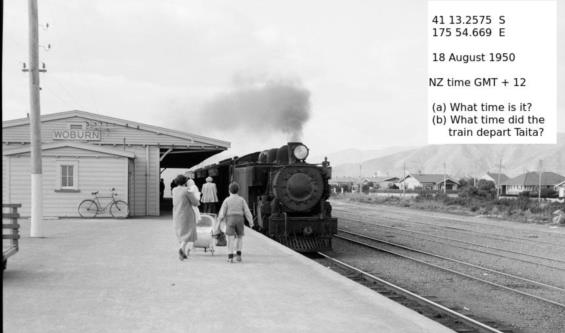
NavList:
A Community Devoted to the Preservation and Practice of Celestial Navigation and Other Methods of Traditional Wayfinding
From: David C
Date: 2020 Aug 22, 21:31 -0700
Here is a small long by chron exercise I have set myself. Question (a) is relevant to this group but it is highly unlikely that anyone will be able to answer question (b). The long by chron part is easy but I have run into difficulty analysing the shadows. I suspect that the boy's shadow falls off the platform edge because the calculated altitude of the sun is impossible for this time of year. If I use the mother's head to foot or head to pram wheel distances I get altitudes that make sense. However if the mother's shadow falls off the edge of the platform it will be impossible to determine the time. I thought about using the azimuth of the sun but that is too inaccurate - a few degrees error in azimuth results in 20min or more in time.
I have asked if a higher resolution version of the photo is available or if the photographer took any other photos at this location on this day. I am still waiting for a reply.
I do not have an almanac for 1950 so I am using dec & eot data for 1930 from Inmans tables. 1950 - 1930 is divisible by four so I suspect that given the accuracy with which I can determine the sun's altitude this is acceptable. I have used the expression GMT because I do not think that UT existed in 1950.
Just in case anyone wants to attempt question (b) in 2020 the Taita - Woburn running time by electric traction is ten minutes. At a guess it would be 15 - 20 min in steam days. In 1947 trains departed Taita at 15 minutes past the hour during the off-peak.
I suspect that in WW2 there were thousands of people analysing shadows in photos. Can anyone please tell me what the time is? [1]
[1] UK forum members wil probably know what I am talking about when I say that Eccles knows what time it is!







